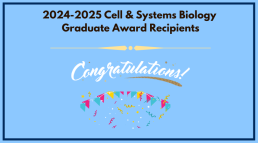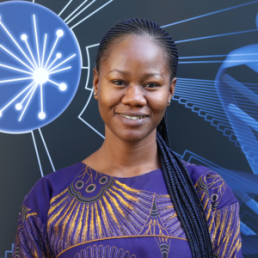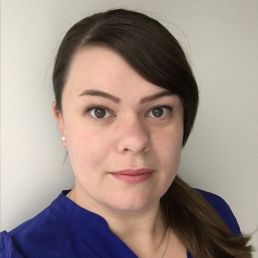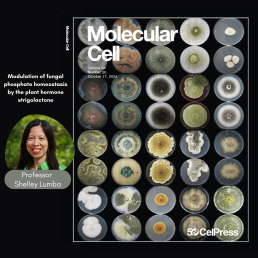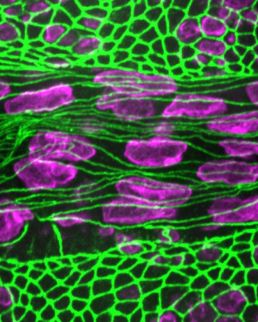Restoration of Rapid Wound Repair Despite Immunosuppressants
Researchers at U of T have determined that immunosuppressants used with transplant recipients slow wound repair by inhibiting the growth of cells adjacent to wounds. They have found ways to restore rapid wound repair in an in vivo animal model.
Prof Rodrigo Fernandez-Gonzalez in the Institute of Biomedical Engineering studies wound repair in the fruit fly embryo. In humans, wound repair is slowed by the immunosuppressant rapamycin, so Dr Gordana Scepanovic in his lab probed the effect of rapamycin on wound healing focusing on the protein target of rapamycin (TOR).
Scepanovic looked at two processes that happen in wound repair; the edges of the wound must be drawn together like a purse string and at the same time the cells around the wound must swell to take up the missing space from the wound.

Scepanovic found that disrupting TOR signalling with rapamycin did not affect the edges of the wound being drawn together. Instead, disrupting TOR prevented cell swelling and slowed down wound repair. Scepanovic used live microscopy and quantitative image analysis to measure wound healing dynamics and cell swelling.
In the absence of a wound, cells constantly digest and recycle small internal particles called lysosomes in a process known as autophagy. Scepanovic found that with normal TOR signalling autophagy was turned down upon wounding. Disrupting TOR signalling caused autophagy to go ahead at its normal level, inducing the cell to consume the materials that should have been used to swell the cell.
Rodrigo Fernandez-Gonzalez recognized the importance of this research from talks with colleagues at the Ted Rogers Centre for Heart Research. “When we first moved here, heart clinicians told me that surgical patients who were treated with rapamycin have difficulty healing their wounds.
“Immunosuppressants are important to prevent rejection of transplants, but transplant recipients sustain a wound from the surgical procedure, and this wound must heal rapidly to prevent infection. So how can we reactivate wound healing even in the presence of immunosuppressants?”
Fernandez-Gonzalez’ lab was able to return rapamycin-inhibited wound repair to normal levels by reducing the levels of proteins related to autophagy using RNA interference in their fly embryos.
They also saw promising results in inhibiting autophagy using the drug bafilomycin, which is known to inhibit maturation of lysosomes into autophagosomes.
The researchers’ detailed analysis of the downstream effects of the immunosuppressant rapamycin on wound healing show promise for applications to improve transplant efficacy.
These important results have been published in the journal Developmental Cell as “mTor limits autophagy to facilitate cell volume expansion and rapid wound repair in Drosophila embryos”.
New tools give an AI boost to plant scientists at the BAR
Huge amounts of biological data generated from plant genomes can now be more rapidly assessed alongside literature describing plant genes thanks to new tools developed by CSB and CS researchers.
Prof. Nicholas Provart founded the globally recognized Bio-Analytic Resource (BAR) server 20 years ago when he recognized the need to collate plant molecular data and provide clear visual summaries for researchers’ queries. Up to now, users had to apply their own interpretations to the data, but Provart and his team have added a new layer to the BAR, designated Gaia.
Gaia collates the interpretations of those who generated the data, summarizing the derived gene models and gene annotation using the latest techniques in machine learning and generative AI.
This curated and processed collection was judged important enough to be included in the Web Server issue of Nucleic Acids Research as “20 years of the Bio-Analytic Resource for Plant Biology”.
Alex Sullivan built the Gaia module for BAR based on data processed by Michael Lombardo, Emma Zhuang, and Ashley Christendat.
Provart acknowledges that “We were dependent on the open science movement, which freely provides all data in a clearly organized manner. Because of this initiative, Gaia can produce high quality, user-friendly output.”
Lombardo developed the GeneNet machine learning method to identify genetic model figures in 67,291 Arabidopsis papers from the PubMed Central database at the NIH.
GeneNet scans journal graphics to determine which figures are likely genetic models using a classification network with a success rate of around 95% (some positive figures are protein-protein interaction networks, not genetic models).
Optical Character Recognition was then used to pull out all the genes mentioned in the figures, which are aggregated to link them in the Gaia database.
 As part of their undergraduate projects, Christendat and Zhuang used generative AI to analyze entries in the Singapore-based PlantConnectome, a GPT 3.5-based summary of >100k Arabidopsis abstracts linked on a gene-by-gene basis across publications.
As part of their undergraduate projects, Christendat and Zhuang used generative AI to analyze entries in the Singapore-based PlantConnectome, a GPT 3.5-based summary of >100k Arabidopsis abstracts linked on a gene-by-gene basis across publications.
Crucially, PlantConnectome maintained the association between extracted information and the paper that the information was derived from by submitting abstracts one-by-one for summarization.
Christendat and Zhuang took this machine-readable database and used skillful prompt engineering through the Llama3 LLM to format the data into a human readable form.
Llama3 was only usable with modifications made by the team. One of their challenges was to ensure the correct journal references were included in each summary.
“It was fascinating to apply my skills to extract meaningful biological data using the latest technology,” enthuses Christendat, a 3rd year student in Computer Science.
BAR is recognized as a Global Core Biodata Resource with two decades of reliable operation through continuous improvements and additions. This new addition shows that BAR will continue to thrive and advance plant science for years to come.
Nambara lab reveals plants' exquisitely tuned responses to high humidity
CSB plant scientists have identified the finely tuned way plants adjust to high humidity conditions. Canadian crops will experience high humidity conditions more often due to increased rainfall and flooding, which enhances the importance of these insights. Professor Eiji Nambara led this research as part of his studies on the ways plants integrate signals of stress in their environment, like drought, pathogens or cold.
Nambara is originally from East Asia, where excess water environments occur frequently in a climate heavily influenced by the ocean. Rice is anatomically shaped to handle excess water such as floods, but wheat crops or the model plant Arabidopsis are adapted to a more temperate climate.
Research by Saad Hussain in Nambara's lab showed that exposing Arabidopsis to high humidity resulted in catabolization of the plant hormone ABA by the ABA-8’hydroxylase enzyme CYP707A3.
He traced the pathway from early high humidity signaling to the decrease of ABA, which facilitates transpiration. Their bioinformatic analysis found that proteins associated with calcium ion signaling were initially activated.
Focusing on calcium, they made an unexpected discovery. When they looked at their plants to see how quickly they responded to high humidity, they saw a glowing calcium signal within a few minutes!
This rapid signal appeared around the periphery of the leaf, near regions called hydathodes. The hydathode is a pore that opens as a relief valve to drain condensed water from the leaf, which helps the plant control water levels in high humidity.
A potential drawback of this response is that bacteria thrive in a humid environment and can infect plants by invading the leaf through the open pore.
Plants have evolved to manage these tradeoffs. Hussain’s results in collaboration with the Yoshioka lab show that high humidity triggering calcium influx into the cytosol goes on to activate ABA catabolism, which in turn induces plant immunity genes. So even though stomatal pores open to increase evaporation under high humidity, the plant is protected from infection.
The plant’s highly tuned regulatory pathways mean that cytosolic calcium concentration can induce opposite responses using same regulatory modules, depending on the input signals. ABA plays a role in cold response, but calcium channels responsible for high humidity responses were activated selectively while cold-responsive calcium channels were unaffected.
This insightful research addressing potential responses to the effects of climate change has been published by the journal PNAS as “Calcium signaling triggers early high humidity responses in Arabidopsis thaliana”.
Graduate student excellence earns impressive awards
Graduate students in the Department of Cell & Systems Biology cover a broad range of fields, including plant science, neuroscience, cell biology, infectious disease research, endocrinology and systems biology. The discoveries these students are making and their contributions to the Department are celebrated in our Departmental Awards.
We are grateful to generous donors for two new awards this year.
Dr. Sergiy and Tetyana Kryvoruchko are supporting future advancements in medical sciences through U of T's Graduate Collaborative Specializations by funding the Graduate Scholarship in Cell & Systems Biology.
Janssen Pharmaceutical has kindly provided an endowment to support students from equity-deserving groups in the form of the Janssen Graduate Award for Equity & Inclusion.
Thank you to all our donors and congratulations to students who earned these awards!
Dr. Christine Hone-Buske Scholarship
Sabrina Barsky (Monks Labs)
Valerie Anderson Award
Stephen Bordeleau (Goring lab)
Kenneth C. Fisher Fellowship
Cindy Hong (Kim lab)
Sheila Freeman Graduate Award in Zoology
Milena Russo (Liu lab)
Dr. Clara Winifred Fritz Memorial Fellowship in Plant Pathology
Tamar Av-Shalom (Guttman/Desveaux labs)
Duncan L. Gellatly Memorial Fellowship
Deepa Chaphekar (Guzzo lab)
Yoshio Masui Prize
Sharanja Premachandran (Calarco lab)
David F. Mettrick Fellowship
Jing Liu (Chang lab)
Dr. Klaus Rothfels Memorial Scholarship
Keerath Bhachu (Nguyen Ba lab)
Senior Alumni Association Prize
Gregor McEdwards (Currie lab)
Hilbert and Reta Straus Award
Jimmy Issa (Ness/Phillips labs)
Vietnamese-Canadian Community Graduate Award
Areej Al-Dailami (Lange lab)
Elizabeth Ann Wintercorbyn Award for Agriculture
Gaeun Shin (McFarlane lab)
Elizabeth Ann Wintercorbyn Award for Medicine
Arvin Persaud (Guzzo lab)
Ramsay Wright Scholarship
Ashleigh Brink (Corbit lab)
Zoology International Scholarships
Jerrica Jamison (Welch lab)
Karan Ishii (Plotnikov lab)
Zoology Sesquicentennial Graduate Award
Benjamin Tsang (Gerlai lab)
Alfred and Florence Aiken and Dorothy Woods Memorial Graduate Scholarship
Jenna Hountalas (Lumba lab)
Janssen Graduate Award for Equity & Inclusion at the University of Toronto
Brittany Mascarenhas (Cheng lab)
Dr. Sergiy and Tetyana Kryvoruchko Graduate Scholarship in Cell & Systems Biology
Irina Alymova (Peever lab) - Neuroscience
Ayasha Abdalla-Wyse (Shafer lab) - Genome Biology & Bioinformatics
Joan M. Coleman Ontario Graduate Scholarship in Science and Technology (QEII-GSST)
Bridget Murphy (Ensminger lab)
Sherwin S. Desser Ontario Graduate Scholarship in Science and Technology (QEII-GSST)
Emily Dong (Chang lab)
Pyruvate paradox resolved by careful carbon flux analysis from Dr Sonia Evans
Dr Sonia Evans in the Phillips Lab has solved the "pyruvate paradox" by showing Rubisco as the main source of pyruvate in chloroplasts.
The flow of carbon within a plant cell determines how fatty acids, amino acid and isoprenoids are synthesized from the three carbon precursor pyruvate.
For decades, scientists observed this carbon flux through precursors like phosphoenol pyruvate (PEP), but couldn’t account for the majority of pyruvate in illuminated chloroplasts.
In fact, Evans' carbon flux analysis found that PEP was a third of what was required for pyruvate production. Using low O2 conditions and mutant analysis, Evans showed that the CO2 fixing enzyme Rubisco provides sufficient pyruvate through the MEP carbon pathway to resolve the pyruvate paradox.
The MEP pathway was thought to be a minor contributor to pyruvate production as MEP (methyl-d-erythritol-4-phosphate) was mainly seen as a precursor for isoprenoids in the plastid. Isoprenoids are used by plants in photosynthesis, defence and communication.
This research is published in Nature Plants as "Rubisco supplies pyruvate for the 2-C-methyl-d-erythritol-4-phosphate pathway".
Evans has a life-long connection with plants and their uses, and earned a Provost Postdoctoral Fellowship to continue her research.
Congratulations, Dr Evans!
CSB support helps Falling Walls Lab Toronto winner get close look at science in Germany
Adnan Sharif broke ground on his interest in plant science research with an undergraduate project on plant immunity in Prof Keiko Yoshioka's lab.
He was inspired to move on to graduate studies in the Faculty of Engineering, where he developed sustainable synthetic hydroponic soil. Sharif went on to win Falling Walls Lab Toronto 2024, a pitch competition for students and recent graduates who want to break down barriers.
The prize for Sharif was flight and accommodations in Berlin before his presentation to the annual Falling Walls Science Summit. The Falling Walls Lab event collected 100 students from 58 countries to share their ideas on breaking down walls.
The German Academic Exchange Service, DAAD, took Sharif and his colleagues on tours of research facilities in Berlin’s Freie Universität. Sharif felt these facilities were comparable to the equipment he worked with in Toronto, both in Cell & Systems Biology and Engineering.
Sharif presented his idea in a three-minute presentation and was inspired by hearing the work of other Lab presenters. He was not selected as the overall winner, but several people from the audience approached him after his talk to learn more.
Falling Walls also has additional talks and panels for more developed ideas from key opinion leaders in the Venture, Engage, Breakthrough, Female Science Talents and Circle streams. Sharif remembers in particular talks from Rafael Prieto-Curiel on modelling cartel activity with data science and from Tiange Wang on explaining climate change with food.
At networking events, Sharif gained insights into the business environment in Germany; “Business leaders I spoke with consider that both generative AI and open science are innovations they will have to focus on in the future. Magdalene Skipper had some interesting perspectives on science publisher's role in Open Science during one of the Round Tables.
“I was struck by the support for SMEs, the Mittelstand, in Germany. I spoke with agricultural investors, including a former minister, who were open to collaborating with Lyrata.” Sharif contrasts this experience with the situation in Canada, “It was harder for me to get started as a founder in Canada without my own personal funds due to the higher cost of capital.
“I was able to get to this point due to the credibility of the University of Toronto. My first funding, my lab space, my colleagues and my letters of support all came from UofT, specifically the Entrepreneurship Hatchery at the Engineering Faculty. Whereas in the German market, I don't feel like the university you come from will dictate those supports.”
Sharif’s future plans include exploring use of his sustainable soil to feed crews in space. Sharif is establishing a collaboration with ARC Plants for Space in Adelaide, Australia to share expertise and experience for this project. This provides partnership opportunities with the City of Brampton; Brampton is a food manufacturing centre, but also home to MDA Space, a mission partner to the global space industry.
Cell & Systems Biology is a sponsor of Falling Walls Lab Toronto, along with Research and Health Science Education at Temerty, Life Sciences Ontario and the Lunenfeld-Tanenbaum Research Institute.
Prof McFarlane's achievements lead to renewal of CRC Chair in Plant Cell Biology
Professor Heather McFarlane has received important support for her research on plant cell walls; her CRC Chair in Plant Cell Biology has been renewed, providing $100,000 in additional funding.
“My renewal as Canada Research Chair in Plant Cell Biology is a tremendous honour and a huge vote of confidence that my lab members and I are conducting original and innovative research.”
McFarlane’s lab members include Natalie Hoffman and Eduardo Ramirez-Rodriguez, who received awards from the Canadian Society of Plant Biologists for their research presentations.
McFarlane’s insightful research with Hoffman “Xyloglucan sidechains enable polysaccharide secretion to the plant cell wall” was featured on the cover of Developmental Cell.
“Support from the CRC program will help my lab advance our research to uncover the fundamental mechanisms of plant cell wall signaling and cell wall synthesis,” McFarlane explains.
“This research is helping us to understand why plants often limit their growth when we try to engineer cell walls to improve important bioproducts, such as green materials and renewable biofuels.”
Congratulations, Professor McFarlane!
Visualizing a healthy future for our plants
Nicholas Provart is recipient of a $2.5M grant from NSERC to build tools that visualize a healthy future for our plants as part of the C-SPIRIT team.
C-SPIRIT is a global project that aims to address the grand challenge of stabilizing food production through harnessing natural chemical diversity harboured in plants and microbes.
Provart, a professor in Cell & Systems Biology, will be responsible for data science activities at C-SPIRIT, including tool development for exploring high content data and interactive database management.
Their research will enhance the usefulness of known plant compounds by providing for bulk synthesis, ensuring efficacy in the field and verifying safe levels of use. Novel compounds will be identified chemically, and their genetic source pinpointed. These discoveries will reveal new pathways to plant resilience.
C-SPIRIT (Center for Sustainable Plant Innovation and Resilience through International Teamwork) convenes plant, microbial, computational, and social scientists from Canada, South Korea, the UK, Japan, and the US.
The Canadian unit of C-SPIRIT is funded by NSERC and will be co-led by Provart of University of Toronto and by Prof Olivia Wilkins of University of Manitoba.
As the metabolites identified by C-SPIRIT are coming from within the ecosystem, they will produce green chemistry solutions for current problems: promoting robust physiological responses will enhance crop resilience against environmental stresses like drought and heat waves; enhancing nutrient uptake will minimize external fertilization; improving plant immune responses will protect crops against increasing pest and pathogen load.
Visualizing diverse datasets is the expertise that Provart brings to C-SPIRIT with his internationally recognized Bio-Analytic Resource for Plant Biology (BAR).
One important aspect of the C-SPIRIT effort is being able to identify and visualize metabolite and gene expression changes in plants under different conditions, organs, and cell types. Knowing this ensures the correct product will be used in the correct tissue.
BAR facilitates this analysis by collating data from the geographic level to the atomic scale. BAR incorporates the latest AI tools and is designated as a Global Core Biodata Resource, reflecting its importance to the global science community.
Provart is enthusiastic about the possibilities for this initiative: "The C-SPIRIT effort really aims to leverage the incredible chemical diversity of plants and microbes to identify and produce natural solutions that stabilize and enhance crop productivity under more expected adverse climates, to support next-generation agriculture that is both sustainable and regenerative"
Congratulations, Professor Provart!
Lumba lab eavesdrops on the secret language of soil molecules
There is a silent conversation going on under your feet; plant roots are communicating with soil fungi through a language of small molecules. Until now, the complex genetics of these fungi made it difficult to study how they perceive small molecules directly.
The Lumba lab and the McCourt lab at the University of Toronto have published research that begins the translation of this secret language in Molecular Cell. They cracked the code by beginning with the model fungus, baker’s yeast. Baker’s yeast is a fungus domesticated by humans for millennia, and their genetic tractability make them well suited to experimentation.
They used strigolactone molecules, which are released into the soil when plants are starving for phosphate nutrients. These chemicals attract certain fungi, which grow within plant roots and transfer phosphate to the plant, leading to improved growth.
Lumba’s lab treated yeast with strigolactone and determined which genes changed in expression. The exciting results made them jump up and pull the rest of the team to the computer to see their finding: the list of most activated genes was dominated by gene labelled “PHO”! The PHO label reflects the gene’s role in response to phosphate starvation. Given that strigolactones are made by plants to coax fungi into providing phosphate for the plant, this was very intriguing.
To probe this response further, James Bradley and co-author Michael Bunsick conducted exhaustive genetic screens revealing that a high-affinity phosphate transporter in the plasma membrane, Pho84, was potentially targeted by strigolactones.
Working with Dario Bonetta at Ontario Tech, they showed that strigolactones could bind Pho84 and that they inhibited phosphate uptake. They also observed that strigolactone treatment caused the Pho84 to be taken away from the cell surface, preventing this transporter from bringing phosphate into the cell.
A combination of mutant analysis and in silico docking conducted by co-author George Ly defined a binding pocket in the Pho84 protein. As would be expected for a binding pocket, changes in the amino acid sequence in this region rendered yeast strigolactone-insensitive.
So, the Lumba lab has teased out a single phrase in the secret language of the soil, but does this phrase mean anything to wild fungus, or do domesticated yeast speak a different dialect? There are two wild fungal species, Fusarium graminearum and Serendipita indica, that were studied in this paper. F. graminearum is a blight on wheat crops in Canada, whereas S. indica promotes plant growth through symbiosis.
The results show that both F. graminearum and S. indica respond to strigolactone by altering phosphate metabolism, showing that strigolactone’s effects are conserved in wild fungi.
Dr. Gopal Subramaniam collaborated with the Lumba lab to conduct pioneering gene editing experiments on F. graminearum. They were excited to find that the F. graminearum’s response to strigolactone acts through the Pho84 transporter.
Scientists can therefore use an approach centered around baker’s yeast to systematically identify and decipher plant-derived small molecules that communicate with fungi.
As we begin to understand this secret language of small molecules, we will understand how the diversity of roots, fungi and bacteria is maintained in the soil ecosystem. This will lead to healthier crops and improve our approach to biodiversity.
You can read more about these results in "Modulation of fungal phosphate homeostasis by the plant hormone strigolactone" from Molecular Cell
Drosophila embryo cells align under pressure through unusual cytoskeletal arrangements
The Harris Lab has discovered that the geometry of the fruit fly embryo creates a crystal-like tissue structure. This revelation was published in the prestigious journal Development as “Confinement promotes nematic alignment of spindle-shaped cells during Drosophila embryogenesis“.
Professor Tony Harris' laboratory studies the development of the Drosophila embryo to understand how cells become arranged before they become the organs in the body. As the embryo develops, a slab of cells called the germband folds over another group of cells called the amnioserosa.
Their research resolves a number of questions. Is the amnioserosa being held gently like you would hold a butterfly in your hand or squeezed like a stress ball? How is the amnisoerosa affected by its handling? What are the cellular structures that are involved?
Tirthankar Ray, PhD student in the Harris lab, studied whether these cells are under compression by cutting them with a laser. In the amnioserosa, the cells collapsed toward the cut site, indicating that the amnioserosa is under pressure from the germband like a stress ball.

Ray, with the help of undergraduate researcher Damo Shi, went on to show that the germband pressure on the amnioserosa results in the cells becoming aligned as overlapping pointed cylinders, or spindles, like the crystals in a mineral.
Germband cell junctions are stabilized by actomyosin structures linked through the alpha-catenin protein. Ray determined that amnioserosa cells, by contrast, are kept in their spindle-like shapes by a scaffold within each cell composed of long microtubule strands.
Compared with germband cells, amnioserosa cells are less reliant on alpha-catenin to remain stably connected, and these cells interact with each other through a relatively unique type of cell-cell adhesion dependent on a protein called Baz/Par-3.
The alignment of many spindle-shaped cells is known as nematic ordering, a physical effect seen with rod-shaped objects from logs in rivers to liquid crystals. Reconstituted cytoskeletal networks and cultured cells were known to exhibit this behaviour, but Ray’s results show the relevance of nematic ordering to the development of animal embryos.
This study contributes a new element to embryo development by showing how organizational effects within a tissue can generate an array of spindle-shaped cells, and how these effects are combined with the physical influence of a tissue-tissue interaction that aligns the cellular array.




